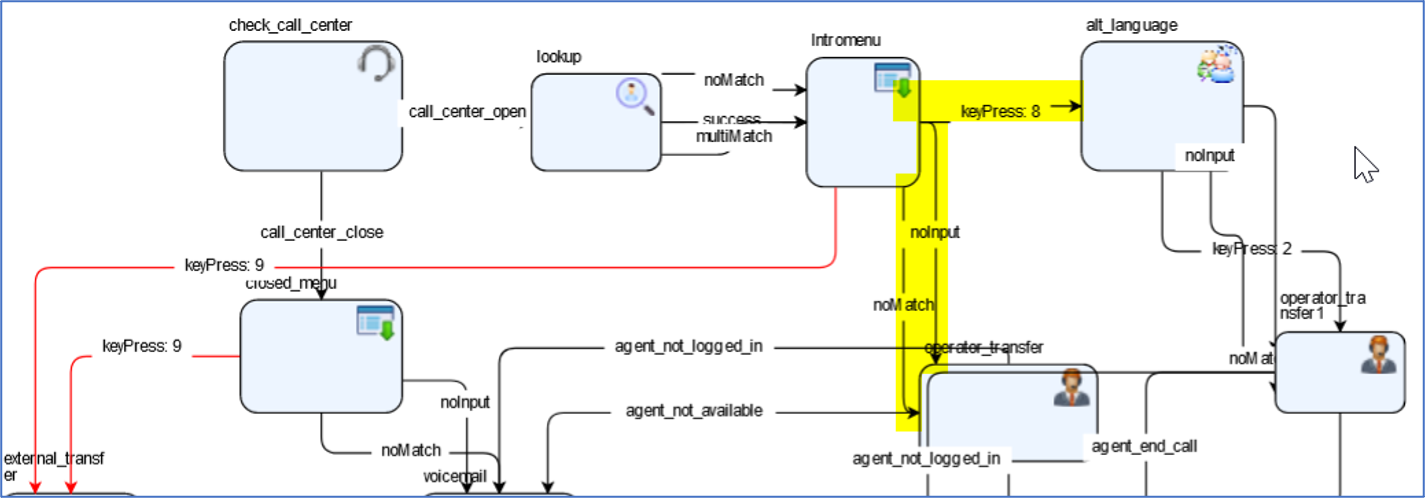Nothing can be more frustrating for an agent than to drop or disconnect a call in the middle of an interaction with a customer. Many times, this can be a simple mistake by the agent, such as:
- Agent accidently clicked the End Call button in their Agent Desktop
- Agent closed out of their Agent Desktop window
- Agent closed their softphone application (such as LiveVox Communicator), causing the connection to fail
- Other PC problems or user error
However, what if the agent was certain it wasn't user error and was instead a LiveVox malfunction? How can we determine why a call was dropped or disconnected before it was supposed to? Let's take a look at a few common scenarios to see what type of conclusions we can come to.
Scenario #1: Calls are Dropping Before Reaching an Agent (Inbound IVR)
Let's say an agent comes to you and states that customers are complaining that their calls were dropping during the inbound IVR (we'd also call these inbound Messages with Contact Flows). This cannot be agent error, but must be a configuration problem with the inbound Contact Flow if the call is dropping before ever reaching an agent.
To identify potential problems with an inbound Contact Flow:
- You'll need the inbound Service name/ID number to take a look at what Inbound Message and Contact Flow are assigned.
- Once you've identified the inbound Service, navigate to the Services tab in your LiveVox Portal (LVP), use the drop-down to find your inbound Service, and select the Phone Numbers tab:

- We're interested in the Inbound Message, so click on the three dots icon next to the message (as seen in the screenshot above). This will bring up the Message/Contact Flow for this service.
- In our sample Contact Flow seen below, we've highlighted what a Connector looks like (arrows or lines) and a Module (large boxes with icons in them).
Connectors allow flow between modules through things like key-presses by a customer ("Press 1 to pay your outstanding balance..."). Modules are actions (once a key-press occurs in a Connector, what happens next).
Now that we've identified our inbound Message/Contact Flow and have an understanding of what we're looking at (Connectors and Modules), let's go through the most common scenarios for IVR failures that result in drops:
- Does your Contact Flow have the proper Connectors? If customers are reporting calls dropping during certain key-presses or actions, make sure that you have an available Connector for their key press and available Connectors if there is no key press or an invalid key press.
- Is the action of your next Module complete? Once a key press occurs during a Connector, it will then move to the next Module action. Is the action it is moving to complete? By "complete:" if the action is to play a message, for example, is that message properly configured with the correct voice talent? Is it missing verbiage? If it is, this Module could fail and drop the call.
- Is the Module action fetching information via API? Check out our API guidance for more information on this topic, but an example would be: if a Module requests information via API (such as customer information based upon the key presses of a Social Security Number), is that request failing? Check with your API subject matter expert to make sure the request is set up properly.
- Is the Module transferring the call to an external number? Let's say the Module action is to transfer the customer to an external number (outside of the LiveVox platform). Is that number still active? Is it down? Try dialing the number directly to see if it is functioning properly.
- Are agents available to take the call? If a Module is to transfer a call to an agent and no agents are available, the Module typically is set up to hold the call until an agent becomes available (also known as Service Max Wait Time). If an agent does not become available and the Service Max Wait Time is reached, that call could drop. Check out your Service Max Wait Time configuration for the module and Service to make sure it is a proper amount of time.
Scenario #2: Calls with Agents are Dropping or Disconnecting
If calls are dropping or disconnecting with an agent on the line, let's look at two ways we can potentially determine why:
-
Concrete evidence of where the disconnect came from - Luckily for us, LiveVox keeps track via call logs of every detail of a call (including which party the disconnect came from). Outside of the scenarios we mentioned at the beginning of this article, calls can also drop because a customer disconnected the call. Maybe they were angry. Maybe their signal was weak. The list goes on and on as to why a customer would hang up, but we are able to determine if they did or not.
However, knowing which party disconnected is not part of the standard LiveVox reporting structure but instead must be determined by the LiveVox Customer Care team. They will take a look at our internal call logs and will be able to see where the disconnect came from. Simply providing them with a call example (phone number, time of the call, which Service) is enough for them to take a look. - Running our TestRTC tool to check connection - As in other call malfunction scenarios, running our TestRTC tool is vital to gauge your own network's health and see if the disconnection is a result of a poor network connection. If we've determined that the disconnection is coming from the agent's side and was not user error, it could be a weak network connection if the agent is remote.